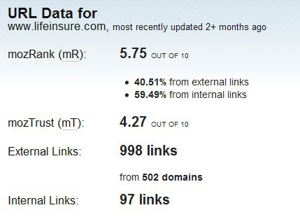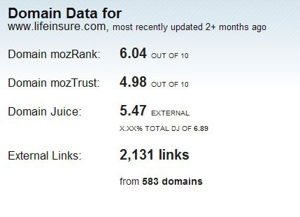One of the most important attributes of search engine optimization (SEO) is link building, which is garnering quality inbound links to a website. A single link from a high-quality, trusted source can raise the rankings of multiple pages on a website because search engines aren’t just counting the link as a vote for the singular page, but also as a vote for the entire domain. So, the process of finding good links is integral to building better PageRank throughout a site, which in turn is vital to improving search engine results for your website.

There are many tools that measure PageRank and report on the existing links any website has. But how do you know if a particular link – relative to other potential links – is worth the time and effort of pursuit? SEOMoz, a well-respected leader in the SEO space, recently launched an interesting new tool that offers new ways to find, measure, and analyze links, including individual links. The tool is called Linkscape, and while it offers some functionality for free, the really good version costs $79 per month.
Offers a ranking scheme similar to Google’s PageRank
Linkscape spiders the web just like the major search engines. In a sense, the tool is reverse-engineering what Google, Yahoo!, and MSN do relative to their linking measurements. There are many useful attributes to Linkscape but at the core, Google’s PageRank is emulated – and improved upon – by mozRank. The primary difference is that while PageRank is reported in whole numbers, mozRank offers detail up to the 1/100th.
At the pro level, reports can be run on websites that show the quantity of links coming into a site; there are several tools that do this, and it is nothing new. But Linscape goes further in determining what those links offer in terms of quality. A couple of key performance indicators include Domain Juice, which is the sum of mozRanks for all URLs in a domain (shown on the same 10 point logarithmic scale that mozRank uses), and Domain Juice Passed, which measures how much juice individual links are passing on (also represented in the mozRank scale).
A couple of key performance indicators include Domain Juice, which is the sum of mozRanks for all URLs in a domain (shown on the same 10 point logarithmic scale that mozRank uses), and Domain Juice Passed, which measures how much juice individual links are passing on (also represented in the mozRank scale).
Helpful to ecommerce sites
So, what is the application of this information for an ecommerce site? First of all, Google’s PageRank can have a lot of variation within a given ranking. A PageRank of 4, for instance could be a high 4 or a low 4; Google does not share that information. A mozRank will show you that a given page has a rank of, for example, 4.08 versus 4.75. Because PageRank and mozRank increase exponentially, there is a large difference between those two rankings – and that information is not available from Google. So, an ecommerce site can better gauge not only pages in their own site, but also pages from which they might be garnering links.
An analysis of Domain Juice can help determine how much of the Internet’s mozRank is on one domain compared with another. But perhaps most importantly, Domain Juice Passed measures the actual value that individual links offer. This is perhaps the single most useful analytic that Linkscape has.
The bottom line is this: There is nothing worse than putting time into garnering an inbound link that, in the end, did very little to boost a page or a website. When it comes time to look for links, an ecommerce site can analyze links – those of competitors or otherwise – more accurately so that time developing links is spent only one those that are valuable.
Pays for itself
Linkscape isn’t cheap, but relative to the information it offers, the investment is worth it to any company who engages in link building with any regularity. Submission to the Yahoo! Directory (and the corresponding link) is $300. At $79 a month or $799 a year, if the Linkscape tool helps an individual to identify and garner even a dozen focused, high-quality inbound links over the course of a year, the tool has more than paid for itself.





